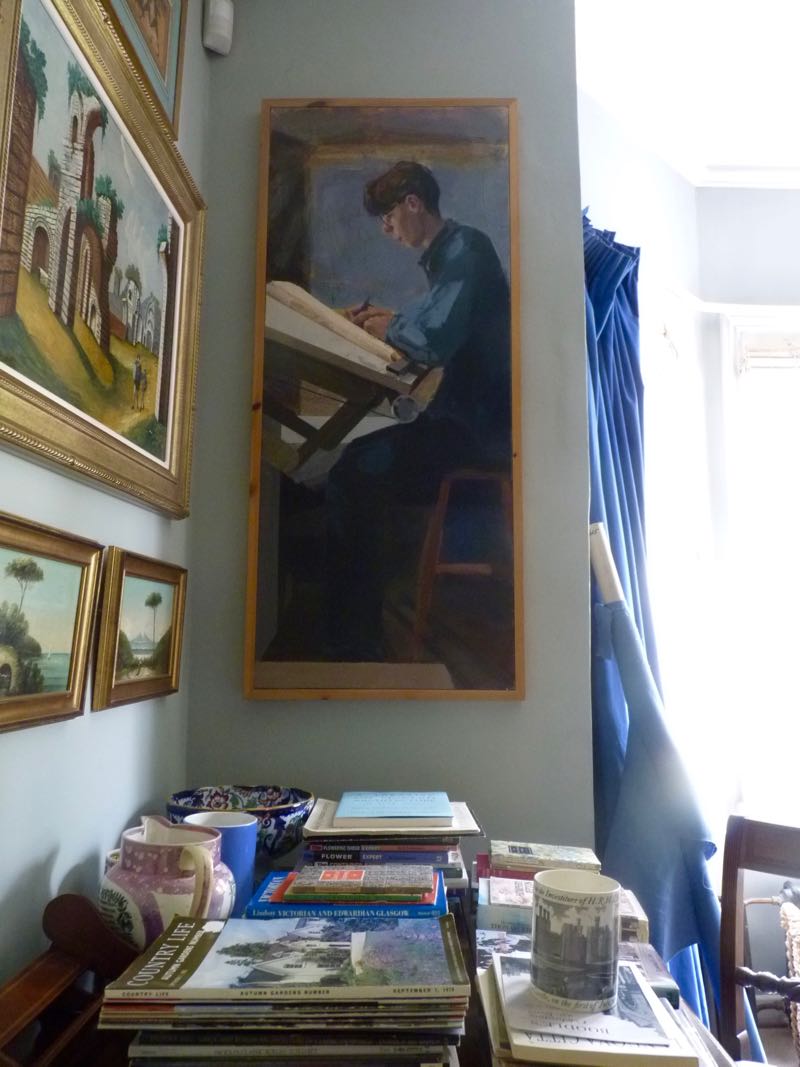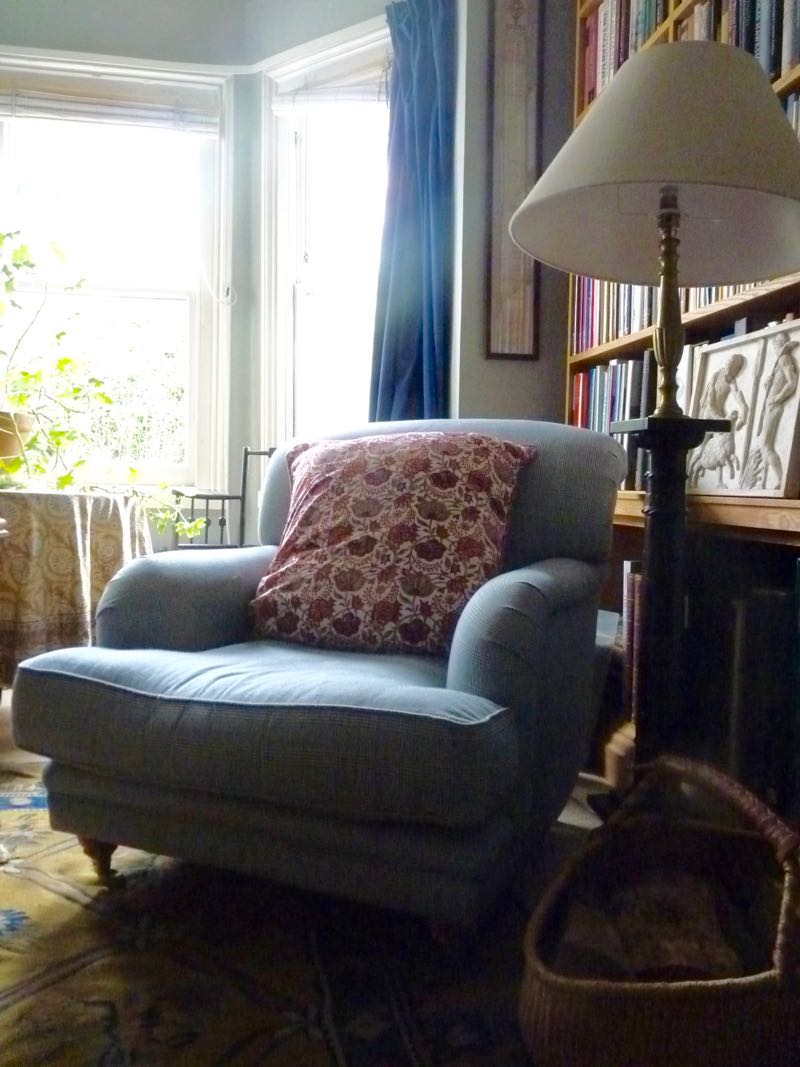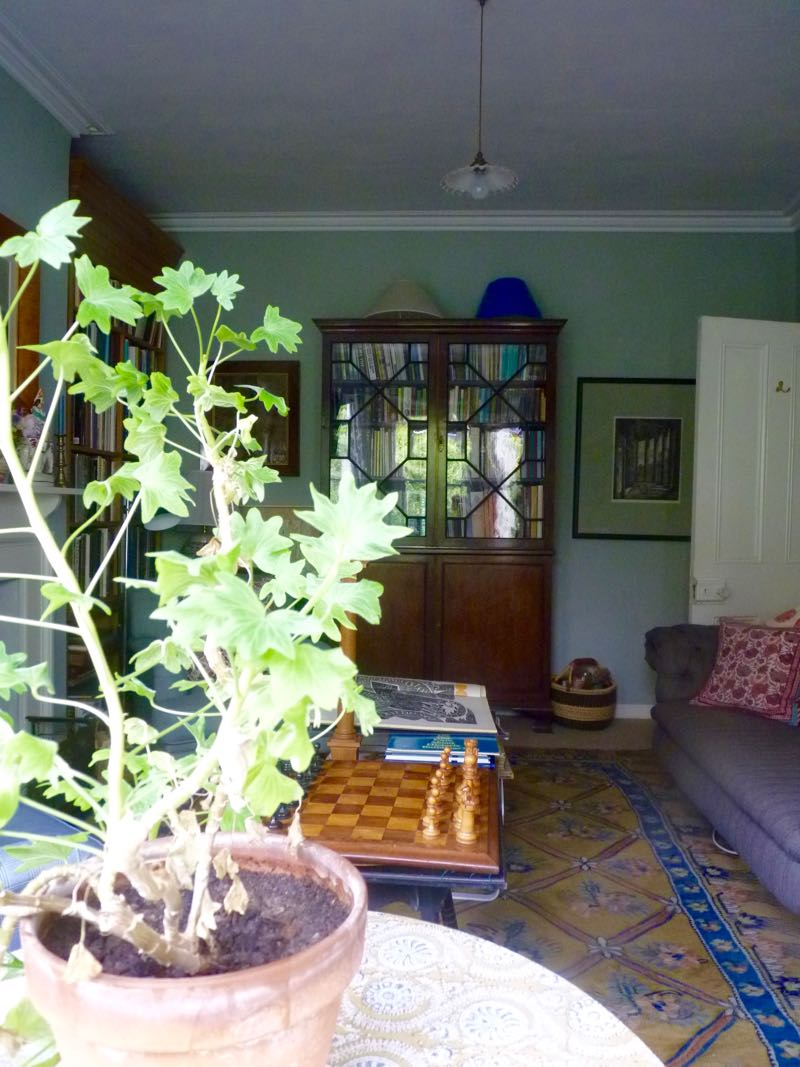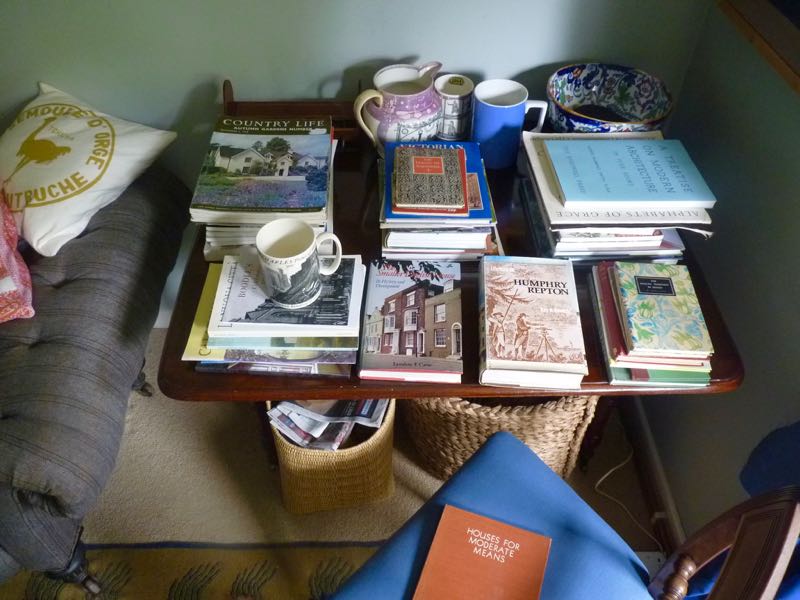
This is the home of George Saumarez Smith in Winchester.

Howard armchair in the basement drawing room

I went there to photograph on a sultry day in August, when the sky was heavy with un-shed rain. ‘I love the house, there’s something very calm and friendly about it,’ George says.

George was a boarder at Winchester College, and then went up to Edinburgh University, to the Architecture department. ‘I started trying to design classical schemes and was made a laughing stock,’ he says. Modernism was the totalitarian doctrine taught everywhere then. But he made one promising friendship, with Ben Pentreath. ‘Ben was reading History of Architecture, he was walking through the department one day and saw a drawing of a Corinthian temple I’d done as a project. He came and found me, and we realised that we had a lot in common. I started doing measured drawings in my last year. And then I went to work for Quin [Quinlan Terry] who, of course, had been in partnership with my grandpa, and then I came here.’ ‘Here’ is his current billet with Adam Architecture where his drawing skills and fluent classical literacy come into play in every commission he undertakes.
![That’s a linocut. When Quin joined my grandfather’s office, he had just designed this house in Essex and Quin turned up saying, I can do linocuts. That’s Kings Walden, my grandfather’s last big house which was done in ’68.The other drawing is by Quin, with my grandfather’s annotations.The plaster cast is a Sandy [Alexander] Stoddart. It’s nice seeing the closed eyelids, finding a good place where the light will fall on it.](https://bibleofbritishtaste.com/wp-content/uploads/2017/10/P1170957.jpg)
That’s a linocut. When Quin joined my grandfather’s office, he had just designed this house in Essex and Quin turned up saying, I can do linocuts. That’s Kings Walden, my grandfather’s last big house which was done in ’68.The other drawing is by Quin, with my grandfather’s annotations.The plaster cast is a Sandy [Alexander] Stoddart. [He is the Queen’s Sculptor in Ordinary in Scotland].It’s nice seeing the closed eyelids, finding a good place where the light will fall on it.’

‘I moved here in about 2007. The house had belonged to two historians, they had a tiny kitchen in the little room at the end of the hall and a sitting room in here with a grand piano.’ George chose to make the ground floor front and back rooms into one large kitchen and dining room.

The sink unit is stainless steel, by Bulthaup, no longer in production unfortunately.

‘This kitchen it really divides people, some come and say, Is this it? I like the fact that it feels like the best of old and new.’

Kitchen cabinet detailing. Everything useful and necessary is contained inside.

Washing waiting.

‘My [ex] wife had very modern taste, when she had gone, there was no furniture left, just the kitchen was here. My piggy bank was completely empty, so it was as if the pendulum swung the other way. I found myself going to auction houses.’.

‘Then I really got into buying pictures. And I’ve been doing a project in India, in Delhi. So whenever I went out there I was buying things like this tablecloth. And now I’ve got far too many cushions and tablecloths!’ The table doubles as a drawing and work table.

‘The right hand print is by Sheila Robinson, it’s of Abingdon High Street.’

Chimney piece.

Edward Bawden’s view of Kew Palace, printed from the original lino blocks.

‘That’s one of the first things I bought locally. They started biding at £200, then it went down to 100, and then it went down to 50 quid. They got down to £20. So I put up my hand and brought it home. It’s kind of junky furniture, but I then I thought, there really something in this. So I’ve sort of bought quite a lot of this – not very good – but kind of comforting furniture.’ Above it hang No’s 1-4 and 5-7, Frog Meadow, Dedham, 1980, linocuts by Quinlan Terry.

‘When I was little, I was always drawing. My parents said, do whatever you like but don’t be an architect!’ But George had another, more direct conduit to his grandfather,Raymond Erith, via his aunt Lucy Archer, author of a monograph and curator of an exhibition on her father’s architectural practice at the Soane Museum in 2004. ‘But the Archers – I loved their house – it made a deep impression. The first time Lucy met me when I was a few days old, I smiled at her, and she’s always had a soft spot for me ever since.’

‘There is a virtuous aesthetic, a bit of ‘Morality and Architecture’ going on here.’

Wivenhoe Park, 1962. ‘That’s a linocut. When Quin joined my grandfather [Raymond Erith] ’s architectural office, he had just designed this house in Essex and Quin turned up saying, I can do linocuts.’

Quinlan Terry’s prophetic early linocut, ‘Fantasy of the House of Joy,’done in 1958 when he was a 21 year old student. An abandoned Oxford chapel smothered in brambles and texts from the Old Testament, that reflected his rejection of the doctrines of Modernism taught at the Architectural Association and his feelings of despair. A few years later, in 1962, Terry joined the traditional practice of George’s grandfather Raymond Erith (d.1973). (I’ve coveted this print ever since I first saw it in 1986.)

‘This is my drawing desk, I’ve been drawing a lot for my RIBA exhibition. I’m not very religious myself but I love religious imagery, and I love church buildings.’

The business plate from his grandfather’s architectural office. ‘I love text, it’s beautifully cut.’

The invitation to his 2010 exhibition at the RIBA, with old friends Ben Pentreath and Francis Terry.

Catalogues for the Raymond Erith exhibition at the Soane Museum, Three Classicists, the 2010 RIBA show (for which I wrote the introduction) and George’s new exhibition there, Measure, Draw, Build.

2 Plates from Measure, Draw, Build, Wudston House, a new Palladian villa in Wiltshire, the Drawing Room and the Dining Hall.

Measured drawing of the detritus thrown into the deep end of an empty swimming pool, San Giorgio Maggiore, Venice, 1997, by George Saumarez Smith, a student project, reproduced from Measure, Draw, Build.

Ben Pentreath, George, Francis Terry and the Parthenon frieze, photographed for Three Classicists. The three have been friends and close associates since the 1990s, when Ben was working for the Norfolk-based designer Charles Morris, George was in Quinlan Terry’s Dedham office and Francis had just joined him there.

The basement floor has become George’s spare bedroom and sitting room. ‘It’s perfect for me and perfect when my children are here, but it wouldn’t really suit anyone else.’

On the table, a monumental printed book of linocuts from the 1960s by architectural draftsman Andrew Anderson, A Vision of Order, 2011, published by the Whittington Press.

‘The sofa’s upholstered in suiting, I bought it at auction.’

NB Wedgwood mid C20th mug to mark the investiture of the Prince of Wales.

The framed 9 sheet linocut print of the Rock of Cashel in Ireland is by Andrew Anderson too. ‘He and a guy called Malcolm Hicks and Quinlan Terry were at the Architectural Association. They were all quite religious and serious-minded. There was a link back to Eric Gill, because the person who taught the art at Bryanston had been a contemporary of Gill’s or something. Andrew and Quin started making linocuts, his are a mixture of theology, architecture and the sea, he really loved boats.’

Staffordshire chimney-garniture and garden posy

The basement spare bedroom. ‘I recently thought it feels a bit grey, so I got wallpaper. The garden at the back is very green, so blues and greens tend to work at the back of the house. Georgian blues, everything was Farrow and Ball. We’re probably the last generation that will know and be able to recite all the original paint names.’ Now George chooses paints by Edward Bulmer.

This paper is designed by Sheila Robinson, produced by the gallery called St. Judes.

The basement bathroom tiles are from Emery and Cie in Brussels. The bath? I just drew it and a joiner made it. It’s teak.’

Front of house.

Back of house, green, green grass between a corridor of loaded apple trees.

George’s first floor bedroom.

George’s bedroom. ‘These are all by Sheila Robinson, she was in the artist’s colony at Great Bardfield with Edward Bawden and all the rest of them. She was taught by him and helped him do the murals at the Festival of Britain. I collect her work, she was incredibly versatile and learned painting and drawing and printmaking at the RCA. She designed for the BBC and produced stamps for Royal Mail. On a good day she is every bit as good as Bawden. Her daughter Chloe Cheese is a printmaker too.’

The bedspread is from Country and Eastern in Norwich

This [top left] is Istanbul in the early 70s, by Sheila Robinson, I bought 3 prints from her daughter.’

‘These cats, all by Sheila Robinson.Every year at the RA she would have a cat painting and they all sold out straight away. That cat is collaged with a fragment of her wallpaper.’

This is by Allan Drummond, an illustration for the weekend Telegraph, the names people give their houses. It was given to me, a present from my godfather Julian Agnew.’

‘It’s Bolsover, by Shelia Robinson, in its original frame, it really should be hung a bit higher.’

Son’s bedroom. ‘My children Wilfie and Barnaby, they’re getting quite grown up they are 13 and 11.’

‘I just bought them made up as cushions in Delhi.’

‘The posters in Wylfie and Barnaby’s room are mine, all of Belle and Sebastian, I was obsessed with them!’

The Master bathroom. Above the bath, ‘its all the rivers in Scotland arranged in a row. It always makes me smile, it’s slightly ridiculous.’

Cunning hanging shelf in the bathroom, a railway carriage luggage rack. ‘This is from a British Rail train.’ When did you start wearing 3 piece suits?’ “Probably straight after university.I’ve probably got enough suits now.’

‘When he was at the AA, Andrew Anderson and Malcolm Hicks and Quin would travel together and they would try to find the plainest and most virtuous building. They found this cottage somewhere in Greece, stone-built with 3 windows and a door, and drew it. But Quin has ended up being more Baroque in his tastes.’ The print above illustrates the Song of Solomon.

A linocut by George. ‘For me they’re just a rainy day activity.’ Its translation reads, A drop hollows away the stone, Not by force but by falling often.’‘It’s really nice, it’s all about things happening gradually.’

This linocut is by George’s young son Wilfy, it’s of one of the flatback Staffordshire figures on the drawing room chimneypiece.

‘My mother produce these interesting things that my [Erith] grandfather or grandmother might have made. This fabric was probably bought by my grandmother [Pamela Jackson], she lived in Chelsea and picked up various things. It might have come from Dunbar Hay, it might have been designed by Bawden. There’s not quite enough for a tablecloth. This knitted blanket was designed by my grandfather and made by my grandmother, Pamela Jackson. This is an old clay pipe found on site at No 10 Downing Street, plus a letter of identification; my grandfather was rebuilding no. 10 after it had been bombed during the war.’
Watch this speeded-up video of George, Ben and Francis making a huge measured drawing – public art – at the RIBA. Scroll to the bottom of the page to find it. Highly recommended.
Thanks to George. All photographs copyright George Saumarez Smith and bibleofbritishtaste.
Excerpts and links may be used, provided that full and clear credit is given to bibleofbritishtaste, with appropriate and specific direction to the original content.








Hello, Ruth,
I’m delighted to see this lovely home – I’ve seen it in various magazines and have always wanted to see more than they have been able to show. I have some writing myself to do this morning but I’m saving this post as a treat for later. All good wishes,
Margaret P
http://www.margaretpowling.com
Such beautiful photographs and commentary.
Thank you very much!
Dream house! These get better every time.
Huge fan in New England, here.
Another lovely house. I especially covet the Sheila Robinson wallpaper.
So many interesting and beautiful things. A great collection of Sheila Robinson’s prints.
I love the basement, although George says, ” …it wouldn’t really suit anyone else.” It would suit me just fine!
Hello Ruth,
I was wondering about the painting of GSS at work at his drawing table, that appears twice in the post above. Who did it? Is it perhaps a self-portrait? The house is wonderful–is there anything nicer than a house filled with books and art?
I enjoyed reading about your visit with Ben and Charlie on Ben’s Inspiration blog!
Best,
Diane
Diane, thank you so much for your extremely nice remarks, I will ask him, and let you know, RG
PS Ive just added the link at the end of the post to a speeded-up film of George, Ben and Francis making a huge public drawing together – very interesting
George says; ‘The portrait was painted by Jane Frederick who is a painter in Colchester and she, Francis and I were great friends in the late-90’s. The painting was exhibited in the BP Portrait Award, in around 1999 I think.’
Thank you Ruth for this article and the beautiful photos and also thanks to George for welcoming us in to his wonderful home with its sense of quiet so conducive to creativity, work and pleasure. There is so much I love: the blue walls in the bathroom and on kitchen cupboards; the “comforting furniture”;the chimney pieces with their pink candles and collection of interesting objects;the linocuts especially Terry Quinlan’s “Fantasy of the House of Joy” and his son’s of the Staffordshire figure. I have “walked through” the house several times already and feel very grateful to you both for giving us such a rewarding experience.
Thank you very much indeed for this generous, comment, I hope that George reads it too.
A delight! Thank you!
Hi Ruth, I have just looked at this blog again and so enjoyed this beautiful house. Great photos and write up. Living in Vancouver is wonderful, but we don’t have glorious old houses like this.
I look forward to many more!
It is delightful to see an architect or designer in Britain whose work enhances rather than destroys the character of so many old buildings. One cannot read Country Life today and not be tempted to bring back the Tower.
Hello George, I used to be your neighbour in sunny Dedham. I admire how you have stuck with your principles in classical architecture. Wonderful house and with a talented eye for detail as ever. I now live in Kangaroo Valley NSW Australia….a long way in may ways from Dedham High Street. Warmest regards. Alex